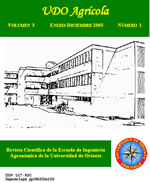
|
Revista Científica UDO Agrícola
Universidad de Oriente Press
ISSN: 1317-9152
Vol. 12, No. 2, 2012, pp. 439-446
|
 Bioline Code: cg12049
Bioline Code: cg12049
Full paper language: English
Document type: Research Article
Document available free of charge
|
|
|
Revista Científica UDO Agrícola, Vol. 12, No. 2, 2012, pp. 439-446
| en |
Effect of roasting process on physical and physicochemical properties, proximate composition and fatty acid profile of the cocoa bean from Miranda state, Venezuela
Lares Amaíz, Mary Del Carmen; Gutiérrez, Rafael; Pérez, Evelina & Álvarez, Clímaco
Abstract
The quality of the cocoa and its butter is the product of the postharvest processes. This process varies from one region to
another in Venezuela, so it is not difficult to infer that this variability would alter the components that define the quality of
the product. Indeed, it could be assumed, that the roasting process leads to variation in weight, percentage of peel of the
grain and also in the fatty acid profile of butter. The goals of this study were: 1) to evaluate the effect of the roasting process
on the physical and physicochemical attribute and proximate composition of the cocoa bean from Barlovento region of the
Miranda state, and 2) To evaluate the fatty acid profile of the butter extracted from the cocoa bean. When comparing the
proximate composition the physical properties, physicochemical and proximal composition only the moisture and crude fat
contents are showing significant statistical differences (p ≤ 0.05) by effect of the roasting. The yield obtained in the cocoa butter
(by the press extraction) was augmented from 30.67 to 32.00% by the roasting process. With exception of the palmitoleic acid,
there were not significant differences in the fatty acid profile by effect of the treatment of toasted.
Keywords
Cacao, quality, fatty acids profile, proximate composition
|
| |
| es |
Efecto del tostado sobre las propiedades físicas, fisicoquímicas, composición proximal y perfil de ácidos grasos de la manteca de granos de cacao del estado Miranda, Venezuela
Lares Amaíz, Mary Del Carmen; Gutiérrez, Rafael; Pérez, Evelina & Álvarez, Clímaco
Resumen
La calidad del cacao y su manteca es producto de los procesos involucrados en el tratamiento poscosecha del mismo. Estos
procesos en Venezuela, varían notablemente de una región a otra, por lo que no es difícil inferir que esta variabilidad altere
los componentes que definen la calidad del producto. Es así, que podemos asumir que el proceso de tostado podría provocar
variación en el peso, porcentaje de testa del grano y perfil de ácidos graso de la manteca. El presente estudio tuvo como
finalidad: 1) evaluar el efecto de la fermentación, secado y tostado sobre las propiedades físicas, composición proximal y 2)
evaluar el efecto del tostado sobre el perfil de ácidos grasos de la manteca del cacao proveniente de la zona de Barlovento,
estado Miranda. Al comparar las propiedades físicas, fisicoquímicas y la composición proximal en las muestras; solo se
observó diferencias significativas (p ≤ 0,05) en el contenido de humedad y grasa cruda por efecto del tostado. El rendimiento
obtenido en la extracción de la manteca (método de extracción por prensa) varió de 30,67 a 32,00% por efecto del tostado.
A excepción del ácido palmitoleico, no se observaron diferencias significativas (p ≤ 0,05) en el perfil de ácidos grasos por
efecto del tratamiento de tostado.
Palabras-clave
Cacao, calidad, perfil ácidos grasos, análisis proximal
|
| |
© Copyright 2012 - REVISTA CIENTÍFICA UDO AGRÍCOLA
Alternative site location: http://www.udoagricola.orgfree.com
|
|
